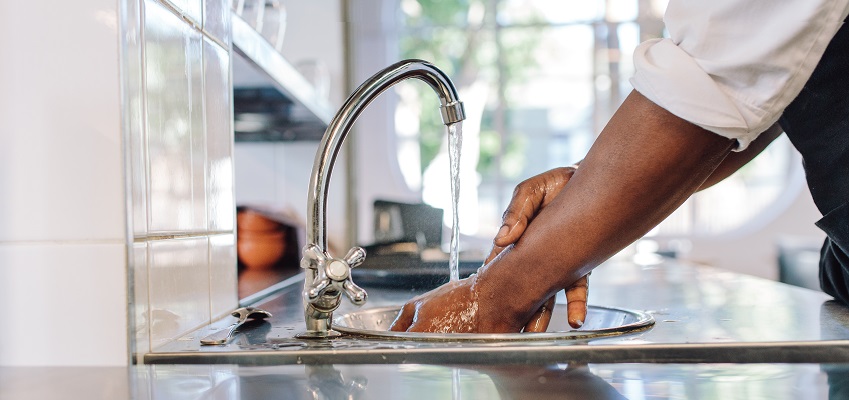Articles
August 08, 2024
Proper handwashing techniques are key to good hygiene
Follow these tips to help protect your restaurant against foodborne illness outbreaks.

Use running water to wet hands and arms. Then, apply soap and make sure to build up a good lather.
Handwashing is one of the most important aspects of personal hygiene, especially where restaurant and foodservice employees are concerned.
It’s essential that food handlers know and understand how to wash their hands correctly so they don’t spread pathogens that could result in foodborne illness outbreaks and put employees, customers, and business reputations at risk.
For more information on food-safety practices specific to the restaurant industry, visit ServSafe.
It’s essential that food handlers know and understand how to wash their hands correctly so they don’t spread pathogens that could result in foodborne illness outbreaks and put employees, customers, and business reputations at risk.
Proper handwashing and hand-care techniques
Make sure your employees follow these six best practices from ServSafe Manager to ensure proper handwashing practices at your establishment.- Wash hands before preparing food, working with clean equipment and utensils, and before putting on single-use gloves.
- Use sinks designated for handwashing. It’s important to monitor this to ensure food handlers never wash up in sinks designated for food prep, dishwashing, or discarding wastewater. Make sure your hand sinks are accessible, clear and fully stocked with handwashing supplies.
- Wash hands or prosthetic devices for at least 20 seconds. When beginning the process, use running water to wet hands and arms. Next, apply soap, and make sure to build up a good lather.
- Scrub hands and lower arms vigorously for 10 to 15 seconds. Then, clean your fingertips, under fingernails, and between fingers.
- Rinse hands and arms thoroughly, using warm, running water.
- Use a single-use paper towel or hand dryer to dry hands and arms. Also, consider using a paper towel to turn off the faucet and open the door when leaving the restroom. It’s important that the food handler doesn’t re-contaminate his or her hands after washing them.
- Using the restroom
- Touching the body or clothing
- Coughing, sneezing, blowing nose, or using a handkerchief or tissue
- Eating, drinking, chewing gum, or using tobacco products
- Handling soiled items
- Handling raw meat, seafood or poultry
- Taking out garbage
- Handling service or aquatic animals
- Handling chemicals that might affect food safety
- Changing tasks
- Leaving and returning to the kitchen/prep area
- Handling money
- Using electronic devices
- Touching anything else that may contaminate hands, like dirty equipment, work surfaces, or cloths
Take corrective action when necessary
If your food handlers aren’t following procedures, correct the situation immediately. If they’ve touched food or food-contact surfaces with unclean hands, you should dispose of the contaminated food; clean potentially contaminated equipment and utensils; and, if necessary, retrain or coach those food handlers who aren’t following proper handwashing procedures.Proper use of antiseptics or sanitizers
Hand antiseptics, also called hand sanitizers, can be used to lower the number of pathogens on skin if they comply with Code of Federal Regulations (CFR) and Food and Drug Administration (FDA) standards. Only use hand antiseptics after handwashing, but never use them in place of it. Also, wait for a hand antiseptic to dry before touching food or equipment.For more information on food-safety practices specific to the restaurant industry, visit ServSafe.
Get the report
Get the report
Sign up for our Newsletter
The latest news from the National Restaurant Association, published every other Thursday
By clicking Submit I agree to receive email communications from the National Restaurant Association and agree to our Privacy Policy(Opens in a new window).
